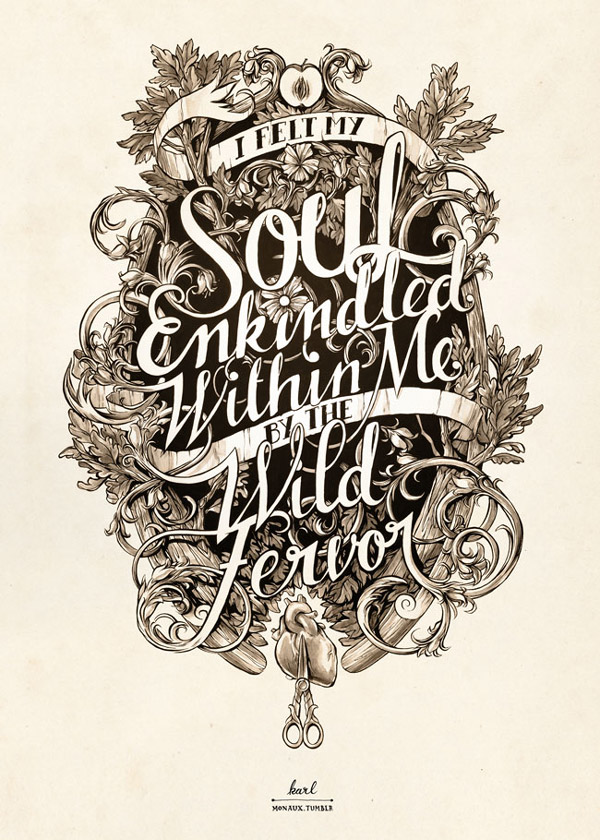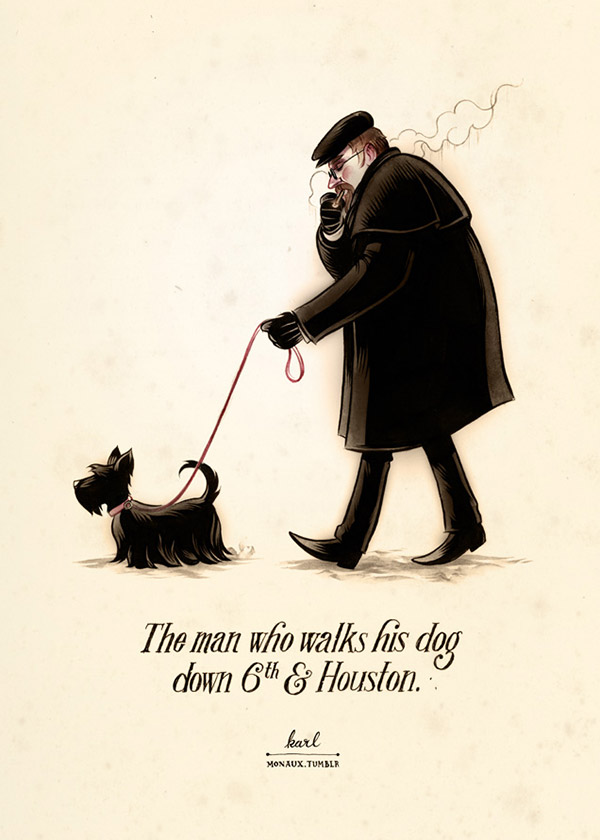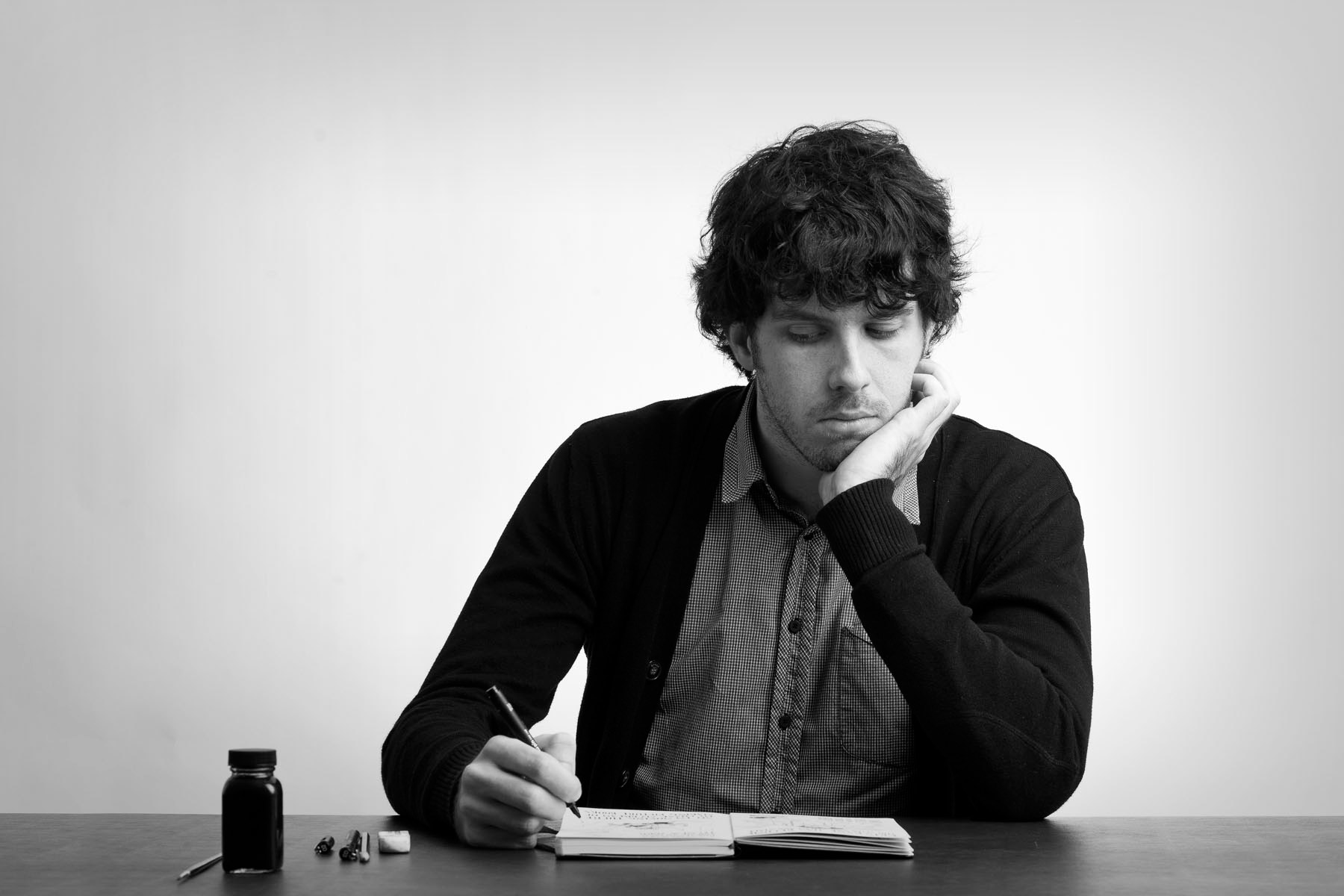
- Interview by Tina Essmaker May 8, 2012
- Photo by Patrick Self
Karl Kwasny
- illustrator
- typographer
Karl Kwasny is an Australian illustrator, typographer, and writer now living in New York City. He works primarily with ink and watercolor and creates pieces that are typically playful and whimsical with a bit of something somber underneath. He has worked as a freelance illustrator since 2007 and is now also in the process of writing and illustrating his own series of picture-books.
Interview
Describe your path to becoming an illustrator.
I suppose that’s a long story. I always liked drawing when I was a kid; it was my favorite thing to do. I’d write stories and draw pictures to accompany them. I kept drawing until I was thirteen or fourteen and then, for some reason, I wrongly decided that it wouldn’t be possible to make a career out of illustration—it just seemed too unrealistic. Instead of continuing to draw, I devoted all my time and effort to design and typography instead.
I went through various university courses and didn’t really know what I wanted to do. First, I studied multimedia at TAFE. I also liked writing, so I studied journalism, creative writing, and film analysis. It took a few years to work out what I wanted to do. The degree I ended up completing was a Bachelor of Design at Queensland College of Art in Brisbane. The course wasn’t up to American standards, I suppose, but it was a good experience nonetheless.
Toward the end of my degree, I chose to get more into illustration. I decided that if I didn’t give it a proper go, I would end up not doing what I actually wanted to be doing in life; I felt like that would be a mistake. While it seemed like a big risk at the time, I decided that instead of getting a design job straight out of university, I would start from scratch and try and make it as a freelance illustrator.
I started looking for freelance work in the last year of my degree. I sent out emails to art directors to establish contact. I wasn’t that great back then; the fact that I didn’t continue drawing through my teenage years made me feel as though my skills were far behind the pack. I still feel that way.
Were you able to get enough freelance work right away to make a living in Australia?
Not to make a living. I was still living with my parents at that time, which made it quite easy. I didn’t have to worry about getting enough work to pay rent. The first company that took an interest in me and let me do what I wanted to be doing was Mooks, which is a fashion label based in Melbourne. The art director at the time was very friendly. That was the first paid illustration commission I had.
From that point, I would try to figure out art directors’ contact details by looking at various companies’ websites. I would send loads and loads of unsolicited emails trying to get any sort of illustration work. Most yielded no reply, but some were successful, so it did work.
Were you able to make the transition to full-time freelancing while you were in Australia or did you work other jobs as well?
I did have a design job for about a year, but that was when I was still at university, so I feel like that doesn’t count. Since leaving university, freelance illustration is all I’ve done as my job.
That’s awesome. And now you’re doing that in New York full-time?
Yup. Also, I should mention that in 2007 I joined what, at the time, was an upstart illustration agency. There aren’t really that many illustration agencies in Australia. The one I’m with, Jacky Winter, has sort of become the most respected illustration agency there.
Was creativity a part of your childhood?
I think any artist would tell you that they were the “good drawer” in class. I tried to write little stories and draw comics as a kid. Aside from that, I don’t really have much else to tell.
Did you have an “aha” moment prior to deciding to give freelance illustration a go?
I feel like, in the back of my mind, it was always what I wanted to do. I studied all of those other things because I felt like illustration wasn’t a realistic career, but it was ultimately what I wanted to do. I wanted to tell stories somehow through the medium of illustration, but I wasn’t sure how. Straight comics didn’t really appeal to me. I appreciate them and I like a lot of them, but it doesn’t interest me to do one, which is why I’m starting to do picture books now.
Yes. We hear you have a book coming out. Do you know when?
Uh, when it’s done. (laughing) I’m giving myself mini-deadlines. I try to do one spread a week amongst other work.
Setting deadlines for yourself is a bit futile, though. If you set a deadline for yourself and you miss it, you feel like you’ve failed. Even though it’s not imposed on you by some external force, it still feels like a failure if you don’t accomplish it. I have kept up with it though, mostly.
Are your family and friends supportive of what you do?
My family is very supportive. And I like to surround myself with people who are trying to do a similar thing—I have friends in Australia and internationally who are artists as well. Having those connections helps motivate me.
Did you have any mentors along the way?
Not really.
Was there a point in your life when you took a big risk to move forward?
I feel like this move to New York is the biggest risk. In Australia, rent is half the price of what it is here. I don’t have any backstops over here; I have to make a lot of money somehow. And I’m away from my family.
Was there a catalyst for your move?
I didn’t have anything tying me to Australia anymore, which was always the reason not to move somewhere. There are so many excuses you can make not to do something. I have a few publishing contacts here as well and I’m trying to get more. It just seems like a good place to be—the right place for me to be right now.
“I kept drawing until I was thirteen or fourteen and then… I wrongly decided that it wouldn’t be possible to make a career out of illustration… Instead of continuing to draw, I devoted all my time and effort to design and typography instead.”
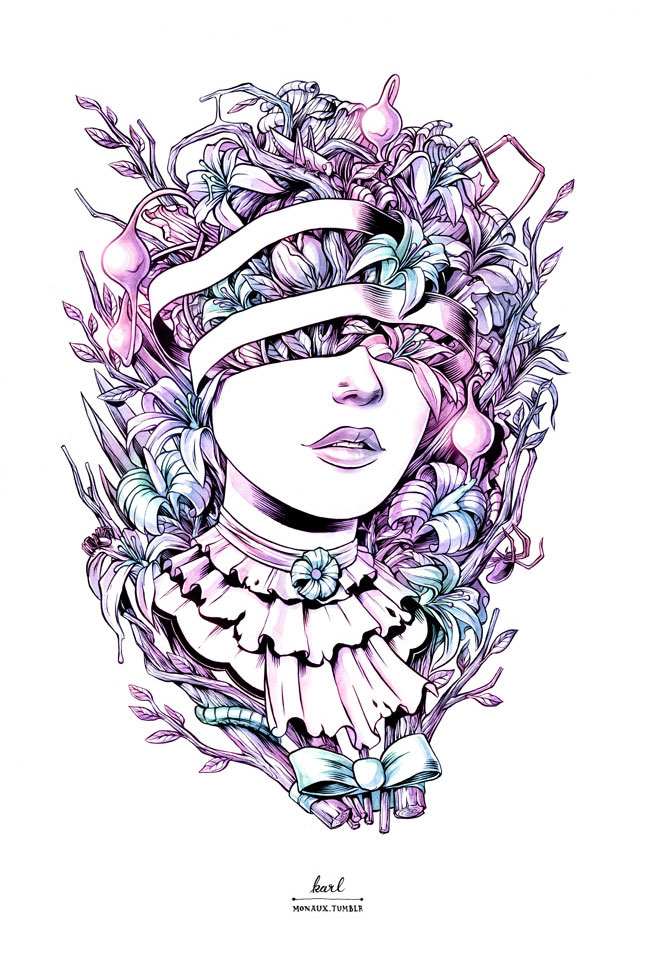
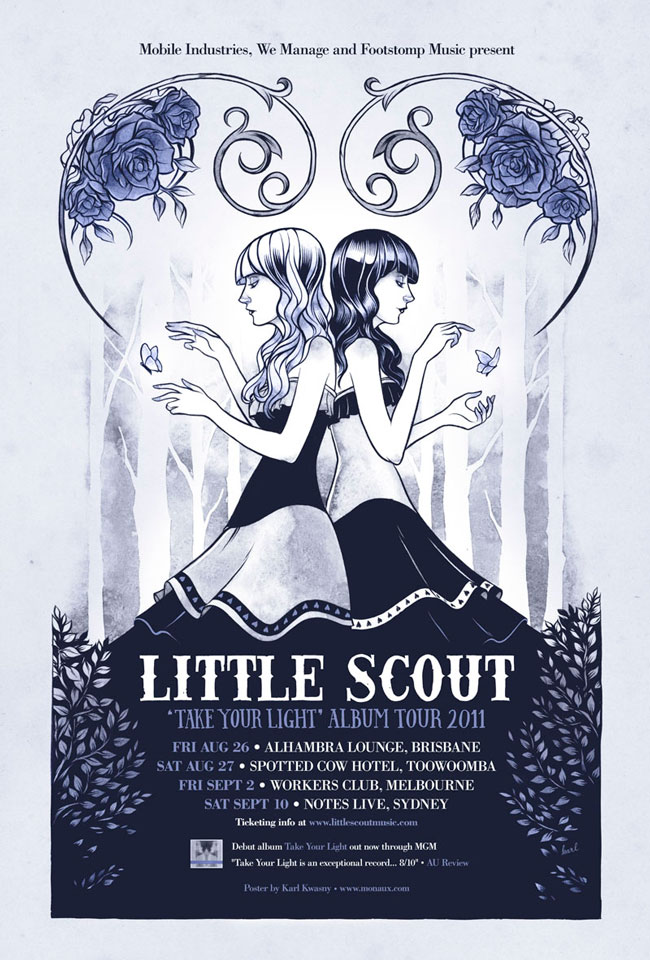
Had you been to New York before you moved there?
I had and I didn’t like it. I was in NY for three days and was only in the Midtown area. I avoid Midtown at all costs now. I didn’t even know about the lower part of Manhattan. I just assumed it was all terrifying, but it’s not.
How does where you live impact your creativity?
I feel like the attitude of people here is vastly different than Australia. Everyone walks faster here; everyone has an objective. Surrounding yourself with those sorts of people and that sort of environment—there’s something about it that makes you more productive. I don’t know why, but I feel like I should be working on something or making something all the time.
Before I moved here, I thought, “I’m going to feel like rubbish in New York because there are thousands of illustrators who are better than me. I’m going to be depressed.” But it’s the opposite when you’re here—that doesn’t matter. You don’t really think about it. Competition is fierce, but the simple fact of being here is a statement that you want to develop your career and be successful. I feel like people have been treating me differently now that I live in NY. The generally accepted view of NY is that it’s where you go if you want to be successful and people treat you that way.
Is it important to you to be part of a creative community of people?
I haven’t done as much networking as perhaps I should, but I already had some contacts before I came here and I feel like I mix with a good group of people.
You answer a lot of FAQs and explain your process on your site. Is that something you’ve always done?
Not really. That’s sort of a recent thing. I like to try to be helpful and I want to be transparent with what I’m doing. I like the idea of encouraging people. I don’t want it to seem like a certain skill level is impossible to attain. If someone asks me an interesting question, I like to answer it and share the answer.
It’s difficult when you see other people achieving things at younger ages than you—it makes you feel behind. You don’t see most artists’ mistakes; they keep them private. I think most people probably think that of me—that I just draw everything perfectly. It takes ages to get a good drawing. It can take ten failed sketches sometimes and obviously, I don’t put those up. I only put up the finished thing.
This goes along with that. Do you feel a responsibility to contribute to something bigger than yourself?
Yeah. That’s what I want to be doing. That is also the purpose of the books I want to make. I have this idea of making a series of books—it’s hard to explain, but I want people to take something away from them and I want them to be helpful. I have one written where the message is that it’s not too late to start. I feel like lots of people don’t end up doing what they want to be doing because it’s not a sensible career choice, but sometimes that’s not what matters.
Are you satisfied creatively?
It depends. I feel like I’m satisfied creatively if I get to do work that I enjoy doing. It seems like it’s happening more often now that I’ve made it clear what my niche is. If you have work that’s too eclectic, people will throw all sorts of jobs at you. If you have a more defined niche, style, and tone, then people will tend to commission you for that sort of work. I didn’t think it was an issue when I started, but it turns out that I’m enjoying the commission work I’m getting now much more than when my work wasn’t so defined.
Initially, I thought it was a good tactic to get more and different sorts of work, but I feel like it’s probably better to have a more focused portfolio—one that’s focused on what you want to be doing.
Where do you see yourself in 5 to 10 years?
All my personal projects are ultimately what I want to be doing with my life. While commission work is good and I do enjoy a lot of it, I’d rather have my personal books be my main source of income. That’s probably a couple years off, but I’m going to keep working on it.
If you could go back and do one thing differently, what would it be?
As I mentioned before, I stopped drawing as a teenager because I didn’t really think there was a future in it. I should’ve stuck with it. But then again, if I did, I probably wouldn’t have the design and typography background that I do now, which is quite beneficial. There aren’t a lot of illustrators doing elaborate hand-drawn typography these days.
Your typography is one of the things that is so intriguing about your work.
I think it adds so much. Typography is often overlooked, and lazy computer typography slapped on an illustration can completely ruin the image. There’s a quote—I’m paraphrasing because I don’t know who said it, but it’s, “The only typography that gets noticed is bad typography.” Good typography works with the image and becomes invisible.
If you could give one piece of advice to another illustrator starting out, what would it be?
Do what you want to be doing. I think you just need to expect not to be good for a long time. I know I used to be extremely frustrated that my work wasn’t to the level that I wanted it to be. That’s the case when you’re learning; it’s five years of extremely frustrating failure. Just be persistent even though your work is bad. Don’t give up.
What does a typical day look like for you?
I try and wake up at a sensible time. I try to keep normal business hours, but it never works out that way. I don’t know if it’s due to how I hold the brush, but for some reason, I can’t ink for more than three hours straight without my hand getting extremely sore. I can sketch for as long as I want though.
I like working during the day. I know lots of creative people tend to work during the night, but I like relaxing at night and going to see shows. That’s one of the benefits of living in New York. A lot of my favorite bands just casually play shows all the time. It would be a show that I would have waited six months or a year to see in Australia. Now it’s just, oh, who’s playing this weekend?
That brings us to the next question. Any favorite albums or bands that you’re listening to right now?
I saw John K. Samson the other day. He’s from The Weakerthans, one of my favorite bands. I just felt like going out and he happened to be playing. He just put out a solo album a month or two ago and it’s really good.
Any favorite TV shows or movies?
Of course! I really like Antichrist by Lars von Trier, but it’s quite a divisive movie. I don’t necessarily agree with the content or what the film is saying, but I like the imagery and tone; I like it stylistically.
I also really like period dramas, Adventure Time, Tim and Eric, most British comedy, and pretty much any black comedy—particularly anything by Todd Solondz or Chris Morris. One of my favorite things is the radio show, Blue Jam. It has such a strange combination of funny-but-disturbing sketch comedy and occasionally hypnotic music. It’s quite similar to dreaming, in a way.
Any favorite books?
Anything by Dr. Seuss, Maurice Sendak, Edward Gorey, Tony DiTerlizzi, Craig Thompson, or Jeffrey Brown; anything unique or inspiring, I guess.
Do you have any favorite food?
I really like Korean food now. When you move to New York, go to Koreatown—it’s great. It is the best food for under $10.
Sounds good. One last question—what kind of legacy do you hope to leave?
I want to be known for doing little inspirational books. I don’t particularly want to make children’s books, but I love using the format. My books will be for my audience, who I consider to be teenagers and adults. I want to make a big series of picture books with inspirational and helpful messages. I want to be one of those guys, like Dr. Seuss or Edward Gorey or Maurice Sendak.
There’s a Steve Jobs quote that I think is quite profound. It’s something like, “Everything in the world was created by someone no smarter than you.” It’s interesting because when a work has been around for a long time or an artist or writer has been dead for a long time, their work becomes this unattainable thing and they become so revered in hindsight that it seems impossible to get to their level; but everyone who ever made anything was the same as the people who are wandering about now. So, it is possible.
“Do what you want to be doing. I think you just need to expect not to be good for a long time. I know I used to be extremely frustrated that my work wasn’t to the level that I wanted it to be. That’s the case when you’re learning… Don’t give up.”
